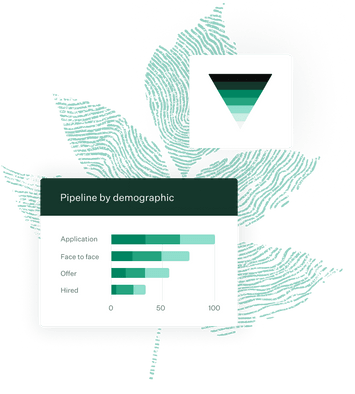Hiring Maturity assessment
Understand the state of your hiring
Your company’s ability to hire the right people is a business necessity. To effectively plan and hire for what’s next, you need to know where you are now. We can help.
How mature is your company’s hiring?
Find out with our Hiring Maturity assessment.
(12 questions, 5 minutes)

What is the Greenhouse Hiring Maturity curve?
Recruiting isn't just a paper-pushing HR function. It's everyone's job. When you get recruiting right, you unlock your company's potential to do everything better.
Understanding how mature your hiring practice is will give you insights into how to improve every aspect of recruiting

Chaotic
Recruiting is mostly reactive and focused on staying afloat

Inconsistent
Successes are driven by individuals rather than teams

Systematic
TA is locking down scalable, proactive process & engaging hiring teams

Strategic
Data driven hiring practices lead to winning candidate experiences
The key to progress is measurement, and that remains true in hiring. There’s no shortage of metrics available to measure how efficient your hiring processes and recruiting workflows have become. Beyond knowing what to measure, there is also the need to know how your TA team’s performance compares to other companies.
Greenhouse works with thousands of companies, helping them to get better at hiring. We have noticed a maturity curve in how companies improve in hiring. Where companies exist on the curve – while not specific to company size or growth rate – indicates what they need to do to get better.
Interested in becoming better at hiring? Take our Hiring Maturity Assessment to discover where you need to focus.
Identify and attract
Successful hiring starts with finding the right people for the right roles when you need them. This set of questions will help you analyze how your employer brand shows up in the world, and the sophistication of the internal processes behind it.

Hiring experience
Creating a great hiring experience goes beyond making candidates feel comfortable, informed and valued. What about your hiring managers and recruiting team? Here we’re asking you to think hard about what the hiring experience feels like for everyone involved, all the way through to onboarding.

Making informed decisions
Better decision-making in hiring doesn’t just happen. It takes thoughtful planning and resource allotment to ensure you have all your bases covered when creating a process that sets you up for hiring success. How does your company’s hiring process stack up?

Operational excellence
Hiring talented individuals is satisfying, but consistency in high-quality hiring is even better. Here we’ll explore how your team uses hiring data and shares information with stakeholders, and how you are setting goals and measuring success.

So, how mature is your hiring?
You're almost done.
We just need a few more details to complete your assessment. You'll be able to review your company’s hiring maturity results on the next page and we'll also email them to the address you provide.
Your hiring maturity assessment results
Identify and attract
Your result:
When it comes to finding and engaging top talent, you should prioritize repeatable processes.
When it comes to finding and engaging top talent, you should prioritize repeatable processes.
Your company has the right foundation to find and engage top talent. But there’s room to improve.
Your company excels at finding and engaging top talent. Stay on top by iterating and innovating.
Identify and attract:
Right now, your company is not identifying and attracting high-quality candidates. Whether your career page needs an overhaul or you're struggling to engage your company to bring in top talent, there’s a lot of room for improvement. Making some smart adjustments will help your company draw
in the right people, drive growth and prepare for what’s next.
Here are a few quick actions you can consider to move up the maturity curve:
- Invest in your career page. Even a light lift, like making sure that candidates don’t have to leave your website to apply, can greatly improve the experience for job seekers. Get inspired by these awesome career pages.
- Document a referral submission process so everyone can easily participate in and track the referrals they submit. This is most accessible with software where all users have to do is upload a resume and the referral will be reviewed by the recruiting team.
- Be proactive by directly sourcing hard-to-fill roles. Don’t wait for great candidates to come to you – go out and find them yourself.
You are on the right path, but your current process is likely reliant on one or two great recruiters and a lot of your efforts are just getting off the ground. You may have started laying the groundwork to identify and attract top talent, but there’s certainly room to grow. Perhaps you’re already encouraging referrals or directly sourcing for high quality, passive talent.
As you keep maturing, here are a few more actions you can consider:
- Identify an executive sponsor to help define and map out your DE&I strategy.
- Offer incentives for referrals and reward engagement as well as results, whether it’s a cash bonus, company-branded gear or a fun raffle every quarter. Having a small incentive in place can help to keep referrals top of mind.
- Encourage internal mobility. As you continue to grow, make sure any opportunities that can be filled internally are shared with current employees, along with a clear process for internal role change. It will help you keep the great talent you already have in the long term.
You are consistently identifying and attracting top talent to your company. You’ve got all the basics down, from a strong referral program to a great hiring brand. Now, it’s time to uplevel and truly separate your team from the rest.
Here are some actionable tips to consider as you continue to mature:
- It’s time to systematize your DE&I goals and efforts. Consider investing in a tool that can help you share your DE&I commitment and keep the right behaviors at the forefront for everyone.
- Set up a strategy that consistently leverages your existing talent base every time you open a new role. That means reconsidering past applicants, reviewing prospects who may have never applied and nurturing relationships with passive candidates over time.
- Ensure your entire tech stack is working well together. Evaluate whether all your key sourcing tools (LinkedIn, Glassdoor, Hired, etc.) can fully integrate with your talent acquisition platform.
The talent you are attracting is your competitive advantage. Your hiring brand and sourcing tactics draw in great candidates. When you open a role, you’re confident you’ll be able to find the right person for the job. Your whole company is invested in recruiting and helping identify the best candidates. Looking to keep improving?
Here are some actions we see the most strategic companies working on:
- Discuss DE&I frequently and thoughtfully, start employee resource groups (commonly called ERGs) and set specific goals.
- Does your organization do campus recruiting? Make sure your on-campus brand reflects your employer brand with well-designed materials and a consistent, easy method to collect info. Tools like a recruiting events mobile app can differentiate your organization.
- Set and report on goals based on the number of different candidate sources. The more varied your sources are, the stronger your talent pipeline will be. Make sure that no single source makes up more than 60% of your pipeline.
Hiring experience
Your result:
When it comes to the hiring experience you’re creating, your company needs to do better.
When it comes to the hiring experience, your company needs to prioritize repeatable processes.
When it comes to the hiring experience, you have the right foundation. But there’s room to improve.
When it comes to the hiring experience, your company excels. Stay on top by iterating and innovating.
Hiring experience:
There’s a lot you can do to improve the hiring experience for candidates, new hires and hiring managers at your organization. Candidates are likely experiencing a poor application experience, slow communication and repetitive interviews. Hiring managers and recruiter relationships are broken. New hires aren’t getting a great first impression of the company.
Here are a few quick actions you can consider to improve these areas:
- Begin to build guidelines for how your recruiters and hiring managers interact. Even if every process is not completely formalized, think through the following at a minimum: how a role gets opened, how a hiring manager gets updated on progress and how a role gets closed.
- Start collecting candidate feedback. Setting up a simple survey is an easy way to get valuable feedback directly from candidates to improve your process.
- Share important information with new hires before their first day. This can include how to prepare, what to expect, how to get involved in the company culture and getting any paperwork out of the way.
You’ve started to lay the groundwork for a good candidate, new hire and hiring manager experience, but still have work to do. Candidates could use more consistency, and hiring managers are just starting to get on the same page as recruiters about hiring.
Here are a few quick tips to continue moving up the maturity curve in this area:
- Create and customize email templates for candidate communication. Consider adding in key information to help candidates best prepare for interviews.
- If you use a tool with a mobile app, roll that out to your team. Having on-the-go recruiting updates and info will help your team become more consistent about submitting interview feedback on candidates.
- Consistently collect candidate and new hire feedback and create a routine for reviewing it, sharing it with the team and implementing changes.
You are consistently providing a good experience for your candidates, new hires and hiring managers. Candidates know where they stand and what happens next in the hiring process. Your recruiting process is seen as a differentiator, and helps you win top performers.
Here are some tips to consider as you continue to mature:
- Invest in an onboarding solution to create a great first impression for new hires. Onboarding technology will allow you to automate paperwork and tech setup tasks, giving you and your team time to focus on important activities.
- Plan recurring training for new talent acquisition team members. Do the same for hiring managers, general interviewers and culture-add team evaluators.
- Set specific goals around candidate feedback, identifying your target percentage of positive candidate experience. Start digging into this data by department, office and candidate demographics to discover areas for improvement.
The experience you provide candidates, new hires and hiring managers is a competitive advantage – and it’s benefiting the entire organization long term. You have the confidence to compete for and win top talent.
Here are actions we see the most strategic companies working on:
- Celebrate new hires by announcing their arrival and inviting everyone to meet them. Consider creating a buddy program to help them adapt quickly.
- Improve hiring manager satisfaction and compliance with internal service level agreements (SLAs) for recruiting processes. Include things like the frequency of pipeline updates and interviews starting on time. Having structured alignment will improve the experience for everyone.
- Give out awards to your Talent Makers. Solidify your partnership with the rest of the company by celebrating those who go above and beyond to support hiring efforts. Recognize talent magnets making referrals, talent partners devoting extra time to give detailed interview feedback and talent leaders who help the entire organization value recruiting.
Making informed decisions
Your result:
Your company isn’t able to make informed hiring decisions. Start taking action today.
You’re on the path to making informed hiring decisions. Focus on alignment and team-wide buy-in.
Your company is making informed hiring decisions. There’s even more you can do.
Your company is highly adept at making informed hiring decisions. Discover how to become a leader.
Making informed decisions:
Currently, your team is struggling with making informed hiring decisions. You are likely experiencing strained hiring manager and recruiter relationships and have a lot of inconsistency within your hiring process.
Here are a few foundational steps you can take to move up the hiring maturity curve:
- Build a structure for collecting feedback after interviews. This can be as simple as creating a form for interviewers to submit post-interview. You can also try meeting roundups to get everyone sharing in one place and streamline the process.
- Plan out each part of your interview process for every role. Each candidate for the same role should go through the same steps and interviews until you make a decision on who to hire. The more consistent your process is, the easier reporting will be.
- Develop a bank of interview questions that interviewers should ask candidates. Need some suggestions? Peruse the examples in this structured interviewing questions guide.
You’ve already started on the right path with hiring decisions, but there are areas for improvement. You’ve laid some of the groundwork, but are still struggling with consistently gathering feedback and getting buy-in from the entire hiring team.
Here are three actions that can be differentiators in helping companies become more systematic:
- Schedule kickoff meetings to align the hiring team on the key details of the role before you open the candidate pipeline.
- Determine specific topics and questions for each interviewer to cover in every interview for a given role. This will help ensure that you are assessing all the essential skills and qualifications before making an informed hiring decision. This guide to structured hiring is a great resource to help get you started.
- Conduct interview team roundups on late-stage candidates to discuss feedback and get alignment on a hiring decision.
You’ve created a solid systematic process for making informed hiring decisions at your company. You’ve likely already built out a structured hiring process where you consistently gather feedback from interviews.
Here are a few tips to continue maturing and become even more strategic:
- Conduct interview training for all new interviewers. Set and follow up on expectations around how soon after an interview feedback is submitted.
- Arm your team with strategies to mitigate unconscious bias during the interview process.
- Conduct a post-hire analysis when you close a role to continue improving and iterating on the hiring plan based on feedback from your recent search.
You’ve turned your hiring decision-making into a competitive advantage. You’re using a structured process to select great candidates for almost every role, giving your company the confidence and tools to consistently hire for whatever is next for you. Even the best companies can continue to grow their hiring expertise.
Here are a few tips to help you truly become a leader in the space:
- Collect data on new hire performance and compare it with feedback from their hiring process. Adjust your hiring plans to take into account how quickly new hires are onboarded and become fully functioning team members, and the breakdown of top performers. This is easiest to pilot with high-volume, entry-level roles.
- Leverage DE&I tools to anonymize candidate data at key points during hiring. Remind or “nudge” interviewers about how to mitigate their own biases.
- Create an offer approval process to ensure that no offer gets approved unless there is data to show the candidate has been fully evaluated on the criteria that the hiring team aligned on prior to opening the role.
Operational excellence
Your result:
Your team doesn’t have the mechanisms in place to evaluate what’s working and how to improve.
Your team functions reactively. Articulate how you’ll get the data you need to adjust processes.
Your team has a good structure in place to find out what’s working and to uncover areas to improve.
Hiring is a strategic partner to your business. Your team can go further with innovative approaches.
Operational excellence:
Your team is struggling when it comes to measuring, iterating on and improving your hiring process. You likely don’t have the ability to determine what is or isn’t working well, struggle with nonexistent or inaccurate data and have tools and processes that aren’t as effective as you need.
Here are a few foundational steps to help you move up the hiring maturity curve:
- Consider alternative tools to help you track and report on hiring efforts. Actually measuring and iterating on your process as you scale will be impossible if you are operating out of spreadsheets and have data living in multiple places.
- Start measuring your recruiting efforts with operational metrics. This mostly involves reporting on pipeline metrics and volume of activity metrics.
- Document the core processes for your team – including which team members should have access to what information and onboarding/off-boarding processes for the talent acquisition team, among many other areas. By recording and storing these workflows in a central place, you’ll be able to scale your operations.
You’ve started to think about setting your team up to measure, iterate and improve your hiring process, but there’s still a lot of work to do. Your team is likely reactive and wary of reporting due to flawed or inaccurate data.
Here are some actions you can take to instill more operational consistency in your hiring:
- Identify the key actions and data points that have to be collected in order to report on hires properly. For example, you need a clear record of who has been hired, and data such as source, recruiter, application date. Plan your process so you collect this data in the same place every time.
- If you’ve already laid the foundation for good reporting by reporting on operational metrics (pipeline data and volume of activity for recruiting), take it a step further by aligning on KPIs. Here is some guidance on where to start.
- Audit the tools your team uses and make sure that most, if not all, are as integrated as possible. If you use an HRIS, it should be connected with your hiring software.
You’ve built a solid, systematic routine to consistently measure, iterate and improve on your hiring process. Your team is aligned on the importance of data integrity and trusts the data you report on. You leverage past learnings and have the right goals in place to continue improving.
As you work to continue to become more strategic, here are three actions to focus on:
- Proactively share essential data with every key stakeholder. Whether it’s executives, hiring managers or your finance team, everyone should consistently have access to all the data they need.
- Consider building a recruiter capacity planning system to become more predictive with team capacity. A points-based system can be a great way to set this up for the first time.
- Ensure the key actions required for data integrity are non-negotiable for your team. They should be keeping track of every important candidate action in a central system. Make maintaining clean data a competency for performance reviews.
Talent acquisition is seen as a strategic partner to the business, and you have granular insight into each dimension of the hiring process. You can consistently identify which parts of your hiring process are effective versus those that need improvement. And you know that even the best companies can continue to grow their hiring expertise.
Here are a few tips to help you truly become a leader in the space:
- Conduct process retrospectives at a regular cadence. Gather key stakeholders involved in the hiring process to discuss what’s going a) well, b) just okay and c) poorly. Be sure to identify action items and next steps for improvement.
- The most strategic companies use data to actually build a predictive recruiting machine – start measuring recruiter performance, reporting on interviewer efficacy and planning for new headcount, all with a robust data set.
- Report on ramp/onboarding time for new hires. Continue iterating to optimize for employees reaching full productivity more quickly and consistently.
Overall Result:
Your team’s recruiting is mostly reactive and focused on staying afloat. There’s a lot more you can do to establish processes and structure to improve all aspects of your company’s hiring.
Inconsistent successes are driven by individuals at your company rather than by the overall team. While you have the beginnings of a successful system, you need to focus on creating repeatable processes.
The talent acquisition function at your company is employing scalable, proactive processes and engaging hiring teams. While you have a solid foundation in place, there’s even more your hiring team can do on your way to excellence.
Your team embraces practices which makes for a winning experience for everyone. Your company’s hiring efforts are seen as vital to your success. While you’re winning on many fronts, you have the opportunity to implement tactics from the best companies to go above and beyond.
Looking to improve your hiring? Let’s talk.
Complete this form to discuss your assessment results with a Greenhouse expert.
Thanks.
A Greenhouse team member will reach out within 24 business hours.
Orientation for new hires: The art of being more human
It’s easy to forget the experience of being a new employee. From preparing for interviews to…
Elevate your talent brand: How to leverage marketing in recruiting (no matter your company size)
This session recording is from Greenhouse Open Conference 2019Talent Acquisition teams know that…
See more hiring guidance